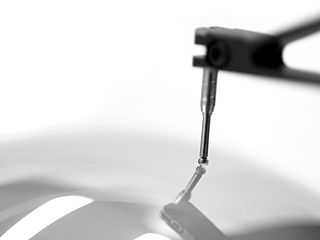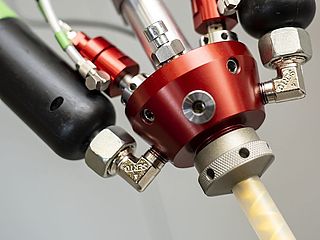Minimal noise, maximum precision

Mahr is known for its tactile and confocal systems. Why does the company now also have a white light interferometer series in its portfolio?
Thorsten Höring: With the white light interferometers, we have expanded our spectrum into the subnanometer range. I think this is only a logical consequence for a metrology specialist like Mahr.
What exactly can white light interferometry do, how does it work?
Thorsten Höring: Basically, white light interferometry enables 3D profile measurements of structures whose size is between a few nanometers and a few micrometers. The method uses the superposition or interference of waves to determine a size. Light travels along two paths: one path leads to the reference, while the second is directed to the surface to be measured. If the object to be measured is in focus, the waves add up and produce an intensity maximum. Out of focus, the waves cancel each other out and result in an intensity minimum. From this information, precise height values can be calculated.
What kind of surfaces are measured in this area?
Thorsten Höring: More and more components have to have surfaces with very special properties – for example, the surfaces of lenses in order to focus properly, or of semiconductors in order to pass on signals quickly. Another example is implants or artificial joints: The surfaces of such endoprostheses must be ground with nanometer precision so that, for example, knee joint endoprostheses made of metal and plastic components interact seamlessly with human bone.

What distinguishes the interferometers from Mahr?
Thorsten Höring: They have a new algorithm, the so-called ICA technology. This combines the good properties of the previously common PSI and VSI methods with a very high vertical resolution and a wide range of applications.
Can you briefly explain PSI and VSI in more detail?
Thorsten Höring: Here I have to elaborate a bit: Conventional methods use either vertical scanning (VSI) or the phase shift method (PSI) for measurements. With VSI, the height values are determined by means of a center-of-gravity method. A characteristic curve forms the so-called "correlogram". If an enveloping line is placed over this, a Gaussian distribution is obtained and the center of gravity can be calculated. In principle, this method is robust and fast, but does not lead to such precise results. The Phase Shift Method, PSI for short, on the other hand, stands for higher accuracy. It looks in the correlogram for the largest "phase difference", i.e. the light-dark change. This method is much more accurate, but much more sensitive. Mahr's white-light interferometers are different: Their novel algorithm combines the good properties of the PSI and VSI methods with a very high vertical resolution in a single large application area.

How does the measurement with ICA actually take place?
Thorsten Höring: With the MarSurf Metrology recording software, the focus area is traversed and a so-called "image stack" of the height information is recorded. This stack is similar to that of a computer tomograph. The stack is evaluated separately for each pixel and thus for each individual data point in the XY direction. From the totality of these points, a "typical" correlogram is defined as a reference and used as a comparison for the evaluation of each data point in the XY direction. In this way, a reliable and accurate height value can be generated. The reference signal is moved along the measured interferogram and the position with the best match is searched. This position is then used to produce the precise height value for that pixel.
How does the low noise of 80 picometers come about?
Thorsten Höring: The fact that ICA makes it possible to determine the height values so precisely minimizes the noise at the same time, which ensures very high data quality. Due to this very good signal-to-noise ratio, the Mahr technology reaches the quality level of a PSI with only 80 picometers (STR Surface Topography Repeatability), but has a significantly better stability and higher reliability. By comparison, previous entry-level instruments are at an STR of around 150 picometers. Moreover, in addition to maximum reliability, the new Mahr interferometers have high dynamic range even at low intensity.
What exactly is the name of Mahr's white light interferometer product line?
Thorsten Höring: It is called MarSurf WI and comprises the three devices MarSurf WI 50 M, MarSurf WI 50 and MarSurf WI 100. This gives research laboratories and quality assurance in industry three powerful devices to choose from to elicit the finest roughnesses, step heights or planes in the nanometer range – in just a few seconds.





















